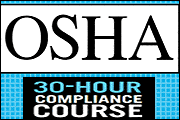Description:

|
Is Not Being In Compliance With OSHA Regulations Costing Your Organization? According to the United States Department of Labor, businesses spend $170 billion a year on costs associated with work-related injuries and illnesses. This can contribute to decreased employee morale, reduced productivity, and higher on-the-job stress, while leading to increased workers' comp claims, higher insurance premiums, retraining costs, absenteeism, and lower-quality products and services. Workers whose employers take steps to protect their health, fitness, and safety on the job are more likely to report job satisfaction, enjoy a higher quality of life, contribute a more optimistic, enthusiastic outlook, and interact positively with peers and superiors. This Intensive Course Was Created To Support OSHA Safety Initiatives, Enhance OSHA Compliance, And Protect Employee Health And Safety Our OSHA 30-Hour Training course represents excellence in OSHA training. Over five days, your trainer will thoroughly explore hazard identification, prevention, and mitigation, as well as OSHA's complex standards, criteria, and requirements, delivering information that is easy to grasp. As a result, you'll comprehend more, remember more, and be better-equipped to apply what you've learned once you've returned to the workplace. Creating your own safety training and support programs, identifying and eliminating hazards and unhealthy situations, promoting a company-wide culture of safety - everything becomes easier when you are not overwhelmed by too much information in a short time frame. This course is interactive, well-balanced, interesting, and most of all - effective. Protect Your Employees From On-The-Job Hazards, And Your Organization From Costly Fines And Penalties With Our OSHA 30-Hour Training Course! Our OSHA 30-Hour training course will give you the practical, hands-on experience you need to pinpoint hidden or overlooked safety and health issues, address them, and become fully compliant with OSHA's general industry standards. Your organization will benefit financially as workers become more productive while less time is lost to injury and illness. The likelihood of hefty penalties and fines levied against you for non-compliance will lessen as well.
AGENDA
Day 1 Welcome And Overview Of The Week's Training - Employers covered by the OSHA Act
- OSHA Training Institute Introduction to OSHA Note: This module includes materials mandated by OSHA
- Employee's rights under OSHA
- Employer's responsibilities under OSHA
- Types of OSHA standards and how they are organized
Safety & Health - Safety and health programs within the workplace
- Management leadership and employee involvement
- Hazard prevention and control
- Safety and health training
Day 2 Record Keeping & Reporting - Reporting procedures to follow for Deaths or Multiple Hospitalizations
- Exceptions
- Record keeping 29 CFR, part 1904
Inspections, Citations, & Penalties - The inspection process: how it works, OSHA priorities, and inspection results
- Employer options after an OSHA inspection
- The different types of violations
- How to contest citations after an inspection
- Follow-up inspections and failure to abate
Walking & Working Surfaces - Guarding holes as well as floor and wall openings
- Ladders: portable metal, wood, and fixed
- Safety requirements for scaffolding
- Fall Protection in General Industry
Day 3 First Aid - Emergency eye washes and showers
- First aid trained first responders
Bloodborne Pathogens - Elements of a successful exposure control plan
- Communication of hazards to employees through signs and labels
- How to determine an employee's exposure
- Sharps disposal containers
- Universal precautions and general safe work practices
- Immunization and post-exposure follow-up program
Personal Protective Equipment (PPE) - Types of protection (eyes and face, respiratory, head, foot, hand and body)
- Lifesaving equipment
- Personal fall arrest systems
- Positioning device systems
Materials Handling & Storage - General materials handling
- Putting together a powered industrial truck training program
Permit-Required Confined Spaces - General requirements
- Required forms of warning
- Pre-entry atmospheric testing
- Required ventilation
Day 4 Lockout/Tagout - Materials and hardware: lockout/tagout devices, requirements, and criteria
- Application of energy control devices
- Shutting down machinery and equipment
- Applying and removing lockout/tagout devices
- Inspection of machinery and equipment
- Contractors, group lockout/tagout and shift changes
Machine Guarding - General requirements for all machines
- Abrasive wheel machinery
- Mechanical power presses
- Hand and portable powered tools and other hand-held equipment
- Welding, cutting, and brazing
Hearing Conservation - Required monitoring of occupational noise exposure
- Required audiometric testing
- Required hearing protection
- Exposure and testing records retention
- Types of investigations, investigative techniques, and investigative procedures
Day 5 Hazardous Materials - Flammable and combustible liquids
- Compressed gasses
- Safety management of highly hazardous chemicals
- Hazardous waste operations and emergency response
Exit Routes, Emergency Action Plans, Fire Prevention Plans, & Fire Protection - Fire prevention plans and detection systems
- Employee alarm systems
- Portable fire extinguishers
- Standpipe and hose systems
- The minimum elements of an emergency action plan
Electrical - Electric utilization systems
- Wiring methods, components, and equipment
- Specific purpose equipment and installations
- Safeguards for personnel protection
Hazard Communication - Purpose of the standard
- Hazardous chemical inventory listing
- Material Safety Data Sheets (MSDS)
- Labeling and training
- Hazard assessment for non-routine tasks
- Work performed by outside contractors
|